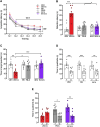Class I histone deacetylases inhibition reverses memory impairment induced by acute stress in mice
- PMID: 38635564
- PMCID: PMC11025869
- DOI: 10.1371/journal.pone.0302374
Class I histone deacetylases inhibition reverses memory impairment induced by acute stress in mice
Abstract
While chronic stress induces learning and memory impairments, acute stress may facilitate or prevent memory consolidation depending on whether it occurs during the learning event or before it, respectively. On the other hand, it has been shown that histone acetylation regulates long-term memory formation. This study aimed to evaluate the effect of two inhibitors of class I histone deacetylases (HDACs), 4-phenylbutyrate (PB) and IN14 (100 mg/kg/day, ip for 2 days), on memory performance in mice exposed to a single 15-min forced swimming stress session. Plasma corticosterone levels were determined 30 minutes after acute swim stress in one group of mice. In another experimental series, independent groups of mice were trained in one of three different memory tasks: Object recognition test, Elevated T maze, and Buried food location test. Subsequently, the hippocampi were removed to perform ELISA assays for histone deacetylase 2 (HDAC2) expression. Acute stress induced an increase in plasma corticosterone levels, as well as hippocampal HDAC2 content, along with an impaired performance in memory tests. Moreover, PB and IN14 treatment prevented memory loss in stressed mice. These findings suggest that HDAC2 is involved in acute stress-induced cognitive impairment. None of the drugs improved memory in non-stressed animals, indicating that HDACs inhibitors are not cognitive boosters, but rather potentially useful drugs for mitigating memory deficits.
Copyright: © 2024 Martínez-Pacheco et al. This is an open access article distributed under the terms of the Creative Commons Attribution License, which permits unrestricted use, distribution, and reproduction in any medium, provided the original author and source are credited.
Conflict of interest statement
The authors declare that they have no known competing financial interests or personal relationships that could have appeared to influence the work reported in this paper.
Figures








Similar articles
-
Histone deacetylase inhibition abolishes stress-induced spatial memory impairment.Neurobiol Learn Mem. 2016 Oct;134 Pt B:328-38. doi: 10.1016/j.nlm.2016.08.009. Epub 2016 Aug 18. Neurobiol Learn Mem. 2016. PMID: 27544851
-
Repeated mild traumatic brain injury causes persistent changes in histone deacetylase function in hippocampus: Implications in learning and memory deficits in rats.Brain Res. 2019 May 15;1711:183-192. doi: 10.1016/j.brainres.2019.01.022. Epub 2019 Jan 18. Brain Res. 2019. PMID: 30664848
-
Epigenetic modifications by inhibiting histone deacetylases reverse memory impairment in insulin resistance induced cognitive deficit in mice.Neuropharmacology. 2016 Jun;105:285-297. doi: 10.1016/j.neuropharm.2016.01.025. Epub 2016 Jan 22. Neuropharmacology. 2016. PMID: 26805421
-
A role for histone deacetylases in the cellular and behavioral mechanisms underlying learning and memory.Learn Mem. 2014 Sep 16;21(10):564-8. doi: 10.1101/lm.036012.114. Print 2014 Oct. Learn Mem. 2014. PMID: 25227251 Free PMC article. Review.
-
Histone deacetylase 3 inhibitors in learning and memory processes with special emphasis on benzamides.Eur J Med Chem. 2019 Mar 15;166:369-380. doi: 10.1016/j.ejmech.2019.01.077. Epub 2019 Jan 31. Eur J Med Chem. 2019. PMID: 30735902 Review.
Cited by
-
From Synaptic Plasticity to Neurodegeneration: BDNF as a Transformative Target in Medicine.Int J Mol Sci. 2025 Apr 30;26(9):4271. doi: 10.3390/ijms26094271. Int J Mol Sci. 2025. PMID: 40362507 Free PMC article. Review.
-
Effects of treadmill running on anxiety- and craniofacial pain-like behaviors with histone H3 acetylation in the brain of mice subjected to social defeat stress.PLoS One. 2025 Jan 27;20(1):e0318292. doi: 10.1371/journal.pone.0318292. eCollection 2025. PLoS One. 2025. PMID: 39869606 Free PMC article.
References
-
- Kanatsou S, Fearey BC, Kuil LE, Lucassen PJ, Harris AP, Seckl JR, et al.. Overexpression of mineralocorticoid receptors partially prevents chronic stress-induced reductions in hippocampal memory and structural plasticity. PloS one. 2015;10(11): e0142012. doi: 10.1371/journal.pone.0142012 . - DOI - PMC - PubMed
MeSH terms
Substances
LinkOut - more resources
Full Text Sources

